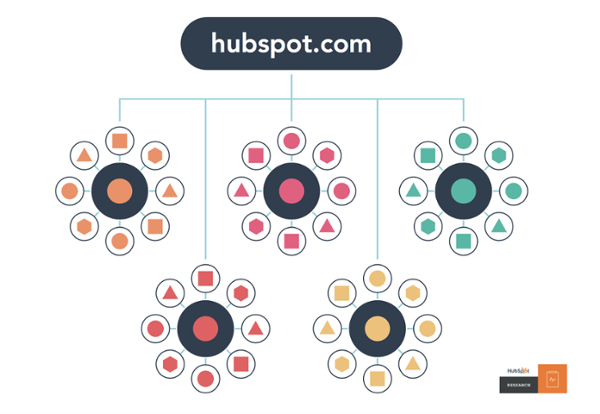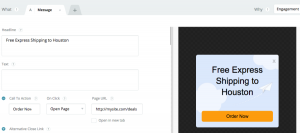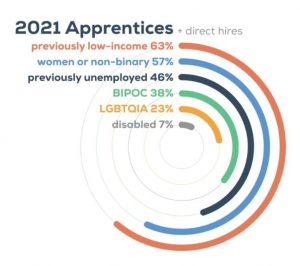— February 28, 2018
Search engine optimization (SEO) is changing. Is your content marketing strategy keeping up?
By now, you have probably heard the buzz about the changing landscape of SEO and the emergence (or reemergence) of pillar pages—un-gated pages of content that broadly cover all aspects of a particular topic. If you’re not familiar, HubSpot provides a great explanation of pillar pages and topic clusters here.
Why create pillar pages?
Essentially, recent changes in search behavior combined with the increasing sophistication of Google’s search engine algorithm have forced inbound marketers to consider restructuring their site’s content in order to land a coveted spot on the first page of search engine results.
A typical inbound marketing structure looks like the chart below, where inbound marketers produce various pieces of content, such as blog articles, around targeted keywords. This results in several scattered pieces of content that work independently to bring organic traffic into the website.

With a pillar page strategy (see the chart below), inbound marketers produce various pieces of content around topic clusters that link back to one single page that covers a broader topic. This newer structure results in a grouping of similar topics that works together to provide more context and deeper information. Not only does this establish greater search engine authority, but it makes it easier for site visitors to find information more quickly. It’s more user-friendly and search-engine-friendly.

Start with a content audit
Like most inbound marketers, you probably have a lot of content already on your site and are wondering where to begin. Performing a content audit helps you identify all of the pieces you can leverage in your pillar strategy, and the gaps in topics you need to fill with new content. While the organization and structure of your content might change a little, the goals of your content remain the same: to add value for your audience. Blog articles, guides, checklists, and other inbound content should already be educational and helpful to your personas at all stages of the buyer’s journey, and they should still be optimized around keywords and other SEO factors.
Here are a few steps to get you started:
1. Build an audit spreadsheet
Start your audit by listing all of your existing content in a spreadsheet, including blog articles, ebooks, guides, checklists, infographics, images, videos, site pages, and any other pieces of information that your audience might be interested in.
Create columns for any information that will help you organize and segment content. This can include (but is not limited to):
- Content type (content offer, blog, infographic, video, etc)
- Page title
- URL
- Keyword
- Topic (general)
- Sub-topic
- Target persona
- Action needed
- Where you are going to link the content to
2. Organize your content
Once you have identified all of your existing content, start categorizing it into general topics. These broad categories will eventually become pillar page ideas. Once your content is categorized, sort the content by topic in the spreadsheet to get some good ideas on where to start your pillar page strategy.
3. Prioritize your content
Next, analyze your content inventory with marketing personas in mind. Identify the most popular pieces of content and the most important content for your buyer’s journey. This content can be great for the topic clusters that link back to a broader pillar page.
4. Identify content gaps
Are you missing quality content in one or more areas? As you consider all of your content and begin to prioritize it, you may identify sub-topics or questions that you haven’t covered. List these opportunities in the spreadsheet as potential topic cluster ideas.
5. Create an action plan
Take a step back and analyze the data in your spreadsheet. Sort by general topic and identify which ones you already have enough supporting cluster content for. Among the broad topics that have supporting cluster content, consider the ones that are most aligned to your business and which ones you most want to be recognized for. Make those topics your first pillar page ideas and add them to the spreadsheet.
Finally, mark the action needed for each piece of content within the spreadsheet. Content within the same topic clusters will need to link to each other, and link back to the appropriate pillar page. Pillar pages will need to link out to each of the topic clusters. Listing all of the appropriate links in this spreadsheet will help you map this process quicker.
Note: HubSpot has a helpful tool for mapping out pillar page content.
Considerations
Throughout your content audit and as you begin writing your pillar page, there are a couple of things to keep in mind.
First, quality content is king. Helpful, insightful, and informative content that delivers on user search intent and satisfaction will have the most value for both your audience and search engines. Second, your content should speak directly to one or more of your marketing personas—addressing their specific interests, pain points, and needs. Finally, a content audit is an ongoing process. It should be revisited at least once a year to gauge performance, identify new topics, and make adjustments to existing content if necessary.
Photo by Janko Ferlic from Pexels
Digital & Social Articles on Business 2 Community
(154)
Report Post







